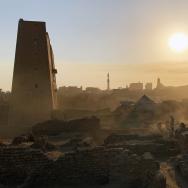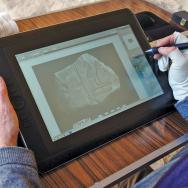More than 3,500 years ago, a rising kingdom called the Hittite Empire was expanding, testing the limits of its strength. It would soon destroy Babylon, but first, its army sacked and burned a city nestled in the mountains of modern-day Turkey called Sam’al—located on a major route of trade between Mesopotamia and the Mediterranean Sea.
The charred ruins from that fateful day were uncovered for the first time in millennia during an excavation by the University of Chicago’s Oriental Institute, which is celebrating its 100th anniversary this year. The excavation is part of the OI’s mission to understand the ancient Middle East, which has helped shape our picture of Western civilization.
“It’s an incredibly lucky find. Every archaeologist hopes for an intact destruction layer because it gives you a snapshot of a day in the life of this town,” said David Schloen, a professor of Near Eastern Languages and Civilizations and a leading scholar of the ancient Middle Eastern world who co-directs the excavation. “Pottery is still sitting inside the buildings where the inhabitants left it in 1650 B.C. You know that everything is where it would be on a typical day, which is really valuable cultural knowledge.”
The site, located at Zincirli (pronounced “Zin-jeer-li”) in southern Turkey, has been excavated by the OI since 2006 (in collaboration with the University of Tübingen in Germany since 2014). Millennia ago, it was the city of Sam’al, and the excavation has documented its rise and fall as an Iron Age kingdom.
Finding an earlier Bronze Age layer beneath it was a surprise, the scholars said. But their latest field season revealed a clear destruction layer, including two burned buildings that had been sealed under collapsed bricks and roof debris. Inside were 10 rooms, small figurines, and shattered but complete sets of pottery. “You can tell the burning was intense,” Schloen said; for example, several storage pots had deeply burned debris around them as though they had contained flammable materials like oil or wine. In another room, a dagger lay on the floor where its owner had dropped it millennia ago.
And unusual for such a finding, the team named the likely culprit. “We’re ready to say a well-known Hittite king, named Ḫattušili I, did it,” Schloen said.
Ḫattušili was a founding ruler of the Hittite Empire, situated with its capital near modern-day Ankara in Turkey. At its largest, the empire stretched across what is now Turkey and northwestern Syria. In the early 17th century B.C. the Hittites were testing their ambitions—and Sam’al was in their radius.
The team was able to point the finger at Ḫattušili I thanks to decades of work documenting the history of the region, especially by the OI—including a long-running project to create the most extensive dictionary of the Hittite language. The Zincirli excavation draws extensively on this research, Schloen said.
“What’s really valuable is having the cultural context to explain all of this,” he said. “This intellectual foundation allows us to excavate a site and have enough of a narrative to try to understand what the economic and cultural impacts of these empires were on a city’s inhabitants.”
For example, the findings included many bowls, drinking goblets, cooking pots and storage jars, which the team plans to analyze to see if there are any traces of what they once held.
However violent the fall of the city was, Schloen said the excavation uncovered no human remains. The people of the city would probably have surrendered and been sold into slavery. “People are worth much more alive,” he said.
The city would rise again, however, becoming a player on the ancient Middle Eastern stage with its own civilization. For example, finds from later periods of occupation at the site include a stone monument from ca. 735 B.C. that provides the first written evidence that people in the region believed the soul was separate from the body.
The Hittite Empire, meanwhile, would go on to sack Babylon. But then its power waxed and waned over the next several centuries. “As it expanded, it butted heads with the other superpower of the day—Egypt,” Schloen said. This conflict would end with a peace treaty in 1250 B.C. that is preserved in both Egyptian and Hittite writings.
Over the years, scores of undergraduate and graduate students have worked at the Zincirli site through the OI, Schloen said.
“There are very few universities in the world with these kinds of substantial, large-scale, sustained field projects that are training grounds for the next generation of archaeologists,” he said. “You can’t learn archaeology sitting in a library—you have to learn it out in a field, and this takes resources and a real institutional commitment. We are especially grateful to our sponsors for supporting this project.”
Since its founding in 1919, the OI has led a century of excavations and research projects throughout the Middle East, many of which continue today in countries including Egypt, Iraq, Turkey and Afghanistan. The comprehensive and rigorous work of OI scholars deciphers ancient languages; reconstructs histories, literatures and religions of long-lost civilizations; and creates transformative dictionaries that serve as cultural encyclopedias essential to understanding the ancient world. As part of the centennial celebrations, the OI Museum’s galleries have been fully renovated and more than 500 new objects have been put on display. Special events as well as artist collaborations are planned throughout the 2019–2020 academic year, kicking off with a public celebration on Saturday, Sept. 28. A full listing is available at the centennial website.
Funding: Neubauer Family Foundation, the National Endowment for the Humanities, the German Research Foundation (DFG), and other sources.

